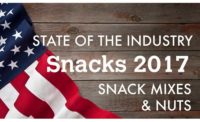At its core, eating quality seals the deal on the repeat purchase of a snack. Those of us in the industry might rank a snack’s hedonistic level—the level of pleasure consumption delivers. Snacks can also face organoleptic scrutiny, determining its positive (or negative) interactions with our senses.
Overview | Chips | Puffed/Extruded Snacks | Popcorn | Snack Mixes & Nuts | Tortilla Chips | Pretzels | Frozen Snacks | Crackers
In their landmark 1993 report published in Appetite, Robert Hyde and Steven Witherly used the theory of dynamic contrast to discuss why people maintain a preference for foods with sensory contrasts like light and dark, sweet and salty—in essence, the sensory psychology of peak palatability. Strong dynamic contrast equates to snacking pleasure.
Peak dynamic contrast underpins the timeless appeal of Cheetos. But a strong impetus for Witherly and Hyde’s research was to determine measurable metrics to guide development of healthful fare, to help ensure success.
While the classic kings of snacks continue their universal reign—nothing will unseat icons like Lay’s, Cheez-Its, Fritos and Doritos for the foreseeable future—a new breed of better-for-you snacks continues to vie for increased market share, often attracting shoppers who have distanced themselves from the snack aisle for one reason or another. But in order to maintain those customers, dynamic contrast must factor into the discussion.
A healthy appetite
“The biggest trend in snacking today is how the category is expanding,” says Elizabeth Avery, president, SNAC International, Arlington, VA. “Not only do snacks play a major role in every retail channel, but consumers are now looking for snacking opportunities in nearly every aisle of the grocery store.”
Mintel research has shown that 94 percent of people snack daily, with nearly a quarter of millennials snacking four or more times a day. And Technomic found last year that over half of U.S. consumers are snacking between their three daily meals. Meanwhile, fewer people than ever are eating three meals per day, instead simply opting for a series of daily snacks. The cumulative effect is that more people are seeking healthier foods to meet their daily snacking needs.
“Because snacking plays such a critical role in Americans’ increasingly fast-paced lifestyles, consumers seek snacks that not only deliver on convenience, but also pack a nutritional punch,” says Avery. “This is leading to unprecedented levels of innovation in the category.”
One of the top health halos in play today is clean label. “Consumers getting the information they seek through simplicity, and transparency about ingredients is critical,” says Christine Cochran, executive director, Grain Foods Foundation, Washington, D.C.
“Consumers increasingly perceive natural, unprocessed, organic and clean label as synonymous with ‘healthy,’” says Avery. “Transparency is critical to today’s consumer who wants to know what is, and perhaps more importantly, what is not in their food.”
While ingredient suppliers continue to find creative ways to seamlessly introduce truly nutritious elements into snack foods, addition of nutrients often requires fine-tuning for best results.
Peak eating enjoyment through application of dynamic contrast and other methods is vital for better-for-you snacks—particularly in snacks designed for children. “While parents are looking for healthier, better-for-you snacks, children are still largely driven by taste,” says Cochran. “A great way to address this would be by introducing better-for-you snacks that are kid-tested and (truly) kid-approved. Innovation in whole-grain snacks is going to be a crucial factor in the better-for-you department.”
And better-for-you snacking has no end in sight. “Because more consumers than ever are looking to snacking as a means of getting the nutrition they need, better-for-you is extremely important,” says Avery. “It is more important today than it was five years ago, and we only see consumer demand for better-for-you products increasing.”
Regulatory hurdles
The snack industry current faces a handful of pressing regulatory matters that will factor into business decisions over the coming year, including ongoing aspects of the Food Safety Modernization Act (FSMA). “FSMA is at the top of the list. The impact on day-to-day operations, manpower, programs, documentation, training, validation, and verification is huge,” says Brian Strouts, vice president, baking and food technical services, AIB International, Manhattan, KS.
Two labeling issues also loom large: updates to the Nutrition Facts panel and disclosure of bioengineered ingredients. “Packaging updates are expensive and take considerable time to execute,” says Avery. “SNAC’s priority is to allow its members to update their packages just once to comply with both regulations. Coordinating these wide-sweeping updates is a common-sense solution that would save time and money, as well as prevent consumer confusion that would undoubtedly arise with back-to-back labeling changes.”
Luckily, the industry has some additional time to react. “FDA’s recent announcement of its intent to extend the compliance date for the Nutrition Facts label was a tremendous win as we work to harmonize the two compliance dates,” says Avery. “There is still work to be done, as the timeline for USDA’s bioengineered foods disclosure rules is unclear, and the new compliance date for FDA’s Nutrition Facts label rules has not yet been announced.”
Another regulatory priority is FDA’s ongoing effort to reduce sodium. “SNAC wants to ensure that all sodium-reduction guidance, whether mandatory or voluntary, follows a review of the totality of the science as it relates to sodium consumption levels and impact on health.”
A flavorful approach
“We are seeing a lot more variety in the options of snack foods available,” says Strouts. “Companies are expanding the number of flavor variations they offer, the combination of flavors and line extensions of existing products. Flavor combines with texture, and that is a good fit with many snack categories—crispy, crunchy, dual-texture. These textures paired with flavor combinations, sweet and salty, hot and spicy, sweet and sour, etc., open up the opportunities for variety.”
Avery notes “explosive growth” across multiple snack categories, including: snack bars; better-for-you and ready-to-eat popcorn; vegetable, pulse and bread chips; and trail mixes, nuts and seeds. “Snack businesses need to think about how convenience-driven snacking and indulgence on healthier snacks is creating a new, diverse snacks market. The consumer they are targeting today is radically different than the consumer of just five years ago.
“Over the next year, snack businesses will be challenged by the need to position brands as healthier, while also ensuring their snacks taste good,” continues Avery. “Above all else, taste still reigns supreme in purchasing decisions. Nearly 91 percent of consumers state they choose snacks based on tastes they will enjoy, according to IRI. Snack businesses will also face increased competition as staple foods try to ‘snackify’ to meet consumers’ changing demands.”
While the category-leading, timeless snacks that have long earned widespread adoration will likely remain largely intact for generations to come, the future of other snack foods remains in flux. In order to resonate in a lasting way with current and future generations of consumers, every snack, regardless of its nutritional merit, will need to have strong dynamic appeal at its core.
Overview | Chips | Puffed/Extruded Snacks | Popcorn | Snack Mixes & Nuts | Tortilla Chips | Pretzels | Frozen Snacks | Crackers








